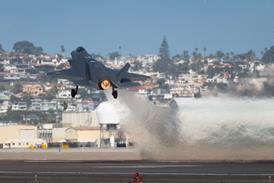GUY NORRIS / SEATTLE
Innovations developed by FlightSafetyBoeing cut up to 10 days off 737NG training
The US Federal Aviation Administration has approved standardised pilot training courses for current production Boeing models that shorten training time by up to 10 days in the case of the Next Generation (NG) 737.
Developed jointly by Boeing and FlightSafetyBoeing (FSB), the Shortened Transition (STAR) pilot training courses are applicable to pilots with prior experience of electronic instrument displays in Boeing-built aircraft. The courses build on this previous experience, and in the case where paired training pilots have differing levels of Boeing "glass" cockpit flying, are designed to be adaptable to suit both during the same course.
FSB says STAR courses for the Boeing 747-400 have a training time of 15 days versus 23 for the previous full transition training time. Similarly the 757 and 767 times reduce to 14 days under STAR against 22 days for the older system, while the 777 time is cut from 22 to 13 days.
In a related move, the FAA has also approved shortened transition pilot training courses for pilots without previous Boeing "glass" cockpit experience. Redesigned by Boeing and FSB using the STAR programme concepts, the new transition training time for all current production models is 21 days, versus 22 for the standard course on the 757, 767 and 777, 23 days on the 747-400 and 24 on the Next Generation 737.
FSB is also working on further training innovations as part of an expansion strategy that is still "on track" despite being slowed by the downturn, says director of aviation training plans and programmes, Craig Clark. "Everything is on hold right now, but a lot of companies are starting to come to us looking for training alternatives. Training is expensive and we think we can do it for less, so in the long term we think we will get some of the 'big boys'," he says, referring indirectly to unidentified major North American and international carriers.
Near term initiatives include the development of new desktop simulation training tools to supplant and eventually replace current computer-based training (CBT) systems. "We are looking at numerous vendors and we will either team or bring them on as a sub-contractor," says Clark, who adds that FSB hopes to "finalise the strategy in 2002 with possible development later in the year". FSB believes desktop training will be an advance over CBT because "desktop is capable of more simulation. The big thing is flight management computers. If you can get pilots to practise on a desktop it frees up much more time in expensive simulators," Clark adds.
Another longer-term plan is the development of web-based training. "At the moment it is limited because the bandwidth doesn't support it, but we have developed a system which allows us to offer an interim form of web-based training," he adds. Under the scheme, pilots would perform recurrence training at home and interact with FSB via the internet. "If we can save one academic day by doing the training at home, with 5,000 pilots say at a particular airline, that's one hell of a saving," says Clark.
FSB says beta testing of a prototype system is under way, with tests of a "full-up" version set for March.
Source: Flight International























